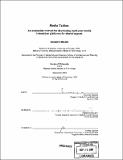| dc.contributor.advisor | Glorianna Davenport. | en_US |
| dc.contributor.author | Mazalek, Alexandra, 1976- | en_US |
| dc.contributor.other | Massachusetts Institute of Technology. Dept. of Architecture. Program In Media Arts and Sciences | en_US |
| dc.date.accessioned | 2007-12-07T19:22:33Z | |
| dc.date.available | 2007-12-07T19:22:33Z | |
| dc.date.copyright | 2005 | en_US |
| dc.date.issued | 2005 | en_US |
| dc.identifier.uri | http://dspace.mit.edu/handle/1721.1/33882 | en_US |
| dc.identifier.uri | http://hdl.handle.net/1721.1/33882 | |
| dc.description | Thesis (Ph. D.)--Massachusetts Institute of Technology, School of Architecture and Planning, Program in Media Arts and Sciences, 2005. | en_US |
| dc.description | Includes bibliographical references (p. 153-157). | en_US |
| dc.description.abstract | As digital entertainment applications evolve, there is a need for new kinds of platforms that can support sociable media interactions for everyday consumers. This thesis demonstrates an extensible method and sensing framework for real-time tracking of multiple objects on an interactive table with an embedded display. This tabletop platform can support many different applications, and is designed to overcome the commercial obstacles of previous single purpose systems. The approach is supported through the design and implementation of an acoustic-based sensing system that provides a means for managing large numbers of objects and applications across multiple platform instances. The design requires precise and dynamic positioning of multiple objects in order to enable real-time multi-user interactions with media applications. Technical analysis shows the approach l:o be robust, scalable to various sizes, and accurate to a within a few millimeters of tolerance. A qualitative user evaluation of the table within a real-world setting illustrates its usability in the consumer entertainment space for digital media browsing and game play. Our observations revealed different ways of mapping physical interaction objects to the media space, as either generic controls or fixed function devices, and highlighted the issue of directionality on visual displays that are viewable from different sides. | en_US |
| dc.description.abstract | (cont.) The thesis suggests that by providing a general purpose method for shared tabletop display platforms we give application designers the freedom to invent a broad range of media interactions and applications for everyday social environments, such as homes, classrooms and public spaces. Contributions of the thesis include: formulation of an extensible method for media table platforms; development of a novel sensing approach for dynamic object tracking on glass surfaces; a taxonomy of interface design considerations; and prototype designs for media content browsing, digital storytelling and game play applications. | en_US |
| dc.description.statementofresponsibility | Alexandra Mazalek. | en_US |
| dc.format.extent | 157 p. | en_US |
| dc.language.iso | eng | en_US |
| dc.publisher | Massachusetts Institute of Technology | en_US |
| dc.rights | M.I.T. theses are protected by copyright. They may be viewed from this source for any purpose, but reproduction or distribution in any format is prohibited without written permission. See provided URL for inquiries about permission. | en_US |
| dc.rights.uri | http://dspace.mit.edu/handle/1721.1/33882 | en_US |
| dc.rights.uri | http://dspace.mit.edu/handle/1721.1/7582 | |
| dc.subject | Architecture. Program In Media Arts and Sciences | en_US |
| dc.title | Media tables : an extensible method for developing multi-user media interaction platforms for shared spaces | en_US |
| dc.title.alternative | Extensible method for developing multi-user media interaction platforms for shared spaces | en_US |
| dc.type | Thesis | en_US |
| dc.description.degree | Ph.D. | en_US |
| dc.contributor.department | Program in Media Arts and Sciences (Massachusetts Institute of Technology) | |
| dc.identifier.oclc | 66464958 | en_US |
